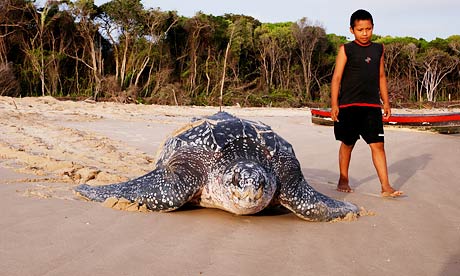So the bio major in me came alive when I stated sorting through some more information about El Salvador. Especially looking at the oceans and the marine life on the coast.
Looking at the map, El Salvador's coastline sits on the Pacific Ocean with four species of sea turtles, with hawksbills, olive ridleys, leatherbacks, and greens nesting on its beaches or foraging in its waters. Of particular importance is Jiquilisco Bay, a nesting area for the critically endangered hawksbill, one of only two major beaches in the entire Eastern Pacific. The other is in Nicaragua.
El Salvador Sea Turtle Species
Hawksbill: El Salvador is an important area for the critically endangered Eastern Pacific hawksbill. They nest here between the months of May and October.

Hawksbill turtles are named after their narrow pointed beak. Their highly colored and patterned shell is the sole source of commercial 'tortoiseshell". They are usually less than 1m in length, weigh 40-60kg, and are less widely distributed than some other species. Their numbers have declinde by over 80% durning the last century, with the number of nesting females estimated at 8,000. The species is classified as Critically Endangered.
Olive Ridley: This species is the most abundant in El Salvador, nesting widely year round on El Salvador's beaches. The peak nesting season for olive ridleys is July-December.
Olive ridley turtles look very similar to Kemp's ridley turtles, but have a deeper
body and slightly up-turned shell edges. They are also slightly heavier,
reaching 45kg. Although the species is widely distributed, the number of important
breeding sites is very low. The species has yet to recover from centuries of
over-exploitation, with the number of nesting females estimated at 800,000. The
species is classified as Endangered.
Green: This country is an important foraging area for green sea turtles. They also nest in small numbers here on a handful of beaches between June and December.
Green turtles are named after the greenish colour of their cartilage and fat.
They grow up to 1.5m long and can reach 200kg. Widely distributed in tropical
and subtropical waters, the number of nesting females is estimated at 203,000.
The species is classified as Endangered, with the Mediterranean population classified as
Critically Endangered.
Leatherback: This species nests in small numbers on a handful of beaches between the months of October and January.

Leatherback turtles are named after their shell, which is leathery rather than hard
like other turtles. They are the largest marine turtle species, typically
reaching up to 180cm in length and weighing 500kg, and also one of the most
migratory, making both trans-Atlantic and trans-Pacific crossings. Widely distributed
in tropical and temperate waters, their numbers have declined precipitously in
most parts of the world in the last century. The number of nesting females is
currently estimated at 34,000 and the species is classified as Critically
Endangered.



